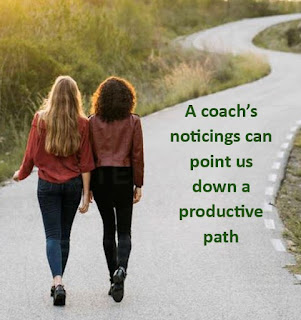During coaching conversations, sharing “noticings”
and asking questions can lead to meaningful targets for instructional
improvement. Those noticings can be generic, gathered over time, or specific to
the teacher you are talking with.
I like to memorize sentence starters so
that I can prompt myself during a coaching conversation. My sentence starter
for noticings is, “I’ve noticed that when
the teacher ____, students ____.” I’ve found this handy sentence stem is
flexible and effective. The noticing can be a more general observation: “I’ve
noticed when teachers use the last two minutes of a lesson for reflection,
students often make new connections.” The frame can be stated as a negative,
“I’ve noticed that when teachers move on to another student after a wrong
answer, kids often shut down” or a positive: “I’ve noticed that when teachers
probe an answer that seems wrong, they can often uncover a kernel of correct
thinking to build on.”
The noticing could also be specific to the
teacher’s class: “I’ve noticed that when you use the doc cam to model, your
kids are clear about directions.” Coaching observations are opportunities for
data gathering. The list we create of specific, objective noticings – what we have
seen and heard – becomes a menu for conversation. When we ask, “Is there a part
of that lesson you’d like to talk about?” there are examples to draw from that
point us down a productive path. Oftentimes conversations that grow from the
noticing stem lead a teacher to her own solution.
These sentence frames worked for me when I
met with Angela, a vibrant early-career teacher who has much to offer the
profession. She walked into my room and even before she was in the seat, she
was venting her frustrations about the lesson I had observed. “The kids were
all over the floor,” she said. “There were two girls playing with each other’s
hair, and half the time the kids weren’t even listening!”
“You sound frustrated,” I said. “Let’s back
up and think about what went right in the lesson.”
“What went right?” she said, seeming surprised.
“Yes,” I queried. “What do you feel good
about?”
“Well, the read-aloud. The kids were really
into that.”
We talked about all the positive comments
and relevant learning that happened during the story. “That book was a great
choice,” I said.
“And I was really pleased that some of the
kids noticed the way I’d grouped the numbers. They noticed it on their own
without me pointing it out. And Edgar – he is really shy and hardly ever speaks
up. I saw when he figured it out. The light bulb went on!”
We gloried in the light-bulb moment, and
then Angela returned to the frustrations she’d expressed earlier. However, she
was now on more solid ground. “But it was still so frustrating that kids
weren’t paying attention during the game!”
“Why do you think that happened?” I asked.
“I’m not sure,” she said, and paused
thoughtfully. “Maybe they didn’t understand the procedures. I just shouldn’t
have tried that game.”
I didn’t want her to give up on the game so
easily! Now was the time for that flexible sentence frame: “I’ve noticed that
when teachers are clear in giving directions, students are more engaged.”
“Yes, I definitely could have been more
clear with the directions,” she said.
“Modeling would help,” I suggested, and
added another sentence with my frame: “I noticed when you were clear in
describing the purpose at the beginning of the lesson, students seemed very
focused. I wonder if they didn’t see how the game connected to that purpose?
I’ve noticed that when teachers keep bringing the activity back to the purpose,
reminding students of the reason for the activity, engagement goes up.”
Wow, that was a lot of noticings! Had I overdone it with that sentence stem,
I wondered?
But Angela’s face suggested otherwise. She
sat up straight and seemed reenergized. “Yes,” she said, “that makes sense.”
Angela thought about how she could be clearer
with directions and we talked about tying each part of the lesson back to the
purpose. As Angela’s experience demonstrates, noticings and questions can lead
to meaningful targets for instructional improvement.
How non-cognitive factors affect learning (and what to do about it):
https://www.edutopia.org/article/building-students-noncognitive-skills
Teaching how to read textbooks:
Teaching critical media literacy:
A podcast on balancing test prep and authentic learning:
https://thecornerstoneforteachers.com/truth-for-teachers-podcast/balance-test-prep-authentic-learning/
It’s still National Poetry Month - Poetry with paint-chip boards:
https://choiceliteracy.com/article/blackout-poems-and-paint-chip-haiku-two-fun-ways-into-poetry-with-adolescents/
That’s it for this week. Happy Coaching!
Want more coaching tips? Check out my book, Differentiated Mentoring & Coaching in Education: From Preservice Teacher to Expert Practitioner, available from Teachers College Press! I’m so excited to share it with you! You can use the code: FDNS25 for 20% off. Click here and I’ll email you the free Book Group Study Guide that includes questions, prompts, and activities you can use as you share the book with colleagues. I hope you’ll love this book as much as I loved making it for you!
This week, you might want to
take a look at:
How non-cognitive factors affect learning (and what to do about it):
https://www.edutopia.org/article/building-students-noncognitive-skills
Teaching how to read textbooks:
Teaching critical media literacy:
A podcast on balancing test prep and authentic learning:
https://thecornerstoneforteachers.com/truth-for-teachers-podcast/balance-test-prep-authentic-learning/
It’s still National Poetry Month - Poetry with paint-chip boards:
https://choiceliteracy.com/article/blackout-poems-and-paint-chip-haiku-two-fun-ways-into-poetry-with-adolescents/
That’s it for this week. Happy Coaching!
Want more coaching tips? Check out my book, Differentiated Mentoring & Coaching in Education: From Preservice Teacher to Expert Practitioner, available from Teachers College Press! I’m so excited to share it with you! You can use the code: FDNS25 for 20% off. Click here and I’ll email you the free Book Group Study Guide that includes questions, prompts, and activities you can use as you share the book with colleagues. I hope you’ll love this book as much as I loved making it for you!


No comments:
Post a Comment